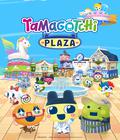Beyond the initial title that introduced the idea of microgames, the WarioWare series has lived on gimmicks. Twisted! relied on the accelerometer in the game cartridge. Snapped! revolved heavily around the use of the DSi's camera. Touched! relied completely on the touch-screen aspect of the Nintendo DS, while Smooth Moves was all about motion controls courtesy of the Wii Remote. After Get It Together!, the first outing on the Switch that revolved around using the system's two Joy-Cons for cooperative play, WarioWare has returned to the system with WarioWare: Move It!, a game that is more of an evolution of what was established with Smooth Moves rather than running with a completely new gameplay mechanic.
While they've never needed narratives, every game in the series has had fairly simple setups and mini-narratives for each character, and Move It! is no different. The local garlic burger restaurant is offering the chance to win a trip to the Caresaway Islands with any purchase. Wario happens to pass by, gets a whiff of the burgers, and orders 50 of them. He ends up winning the prize, but the catch is that he has to bring 20 friends with him, which results in everyone from the WarioWare crew going along for the trip. Everyone is given items called Form Stones, which look suspiciously like Joy-Cons, for good luck before they go on their individual adventures, such as Jimmy T. surfing on a shark, Mona diving in the ocean to look for a mermaid, and Dribble and Spitz inadvertently entering a jet ski race.
Story mode is going to be the initial entry into the game, and it faithfully follows the established formula of the series. After some setup for that character's story, you're sent into a microgame with a vague prompt about what you need to do. You're given a few seconds to figure out what's being asked of you, how to execute it, and complete the task before the game is over and you're whisked away to the next game. The subject of each microgame varies wildly, including pulling all of the tissues from a box, stopping a train at the station, rolling yourself in panko crumbs, and plucking Pikmin from the ground. Completing microgames speeds up the pace before you end up in a boss fight, which also ranges in absurdity, from lighting up a cannon to defeat an ant army to defeating muscular men by throwing the cards at them. There are over 220 of these microgames, and fans will be pleased to see that the trademark silliness of each endeavor is still greatly intact.
As mentioned before, the gimmick is the fact that every microgame employs motion controls, and they're all tied to some kind of pose that you need to begin with. The first time you encounter one, the game presents you with a diagram and explanation of each pose before providing a hilarious tangential anecdote. After that, the game shows a quick picture of the necessary pose before starting the microgame. Just like the microgames, the poses range from something simple, like placing your hands on your side to putting them against your cheeks. Some poses have you squatting or placing one hand on your mouth and the other on your butt, like you're mimicking a duck. One may have you placing the Joy-Cons on the ground to later pick them up, while one pose has you using the IR sensor of the right Joy-Con, a feature that has only seen use in a handful of games for the system.
For the most part, the use of motion controls works as far as making the game as funny as previous entries. Having to squeeze your thighs to catch a fish or wagging the Joy-Con near your butt to make Mario fly in his racoon suit remains hilarious no matter how many times you do it. It helps that the accelerometers in the Joy-Cons are better than the Wii when it comes to performing tasks like this. That said, the controllers aren't completely accurate all of the time, and there will be times when your movements won't register. Part of the issue seems to stem from speed, as moving at a normal speed might be considered too fast for the Joy-Cons to register. For example, moving the weathervane to face the wind might not register your movements unless you slow down the turning speed.
Another issue is that the devices still need some exaggerated movements to register. The Icarus boss fight best exemplifies this, as you need to flap your wings, but you sometimes need grand motions for the flapping to be seen. The fact that the need for proper speed and exaggeration is dependent on a per-microgame basis means that there are microgames that have great concepts but fiddly executions. There seem to be more that you'll actively come to loathe when compared to other entries in the series.
Story mode also adds an extra wrinkle to the proceedings in the form of Second Chance Poses. Lose all of your lives in any chapter, and you'll still get a Game Over screen, but you'll also get taken to a screen where you have three seconds to copy the displayed pose. Do it successfully, and you'll return to your chapter with a full set of lives and your progress intact. The game is very lenient when it comes to recognizing those poses, and you can employ the second chance as many times as you want. It means that finishing the Story mode seems inevitable thanks to the removal of the Game Over barrier, but completionists will actively try to mess up to see this screen since they're collectible like the microgames, and there are a total of 104 to discover.
Story mode can be played solo or cooperatively, and you'll spend a good deal of time on it if your goal was to unlock all of the Second Chance Poses and microgames. Beating Story mode unlocks other modes. Double Act has you only playing co-op microgames with a friend in tow. Megagame Muscles is a solo mode that has you going through roughly 20 microgames with a counter that you power up as you complete or fail each task, but the use of muscles as a measurement isn't quite as helpful as something more common, such as calories, despite fitting the series' overall wacky theme. Switching Gears has two players taking turns playing the microgames while the non-active player is constantly moving around to keep the screen from becoming a blurry mess. Showdown is a simple versus mode where two players compete to complete the microgames the fastest. They're fairly fun modes, but it would've been nice to see them accessible in the main menu instead of having to dig through the Story mode's island structure to find them.
Copycat Manor is another two-player mode, but it's located in the main menu. This is perhaps one of the more fascinating modes, as it is cooperative but set up similar to something like Keep Talking and Nobody Explodes. One player has a complete view of the screen but doesn't hold the Joy-Cons, while the other player with the Joy-Cons can't see the screen. The player facing the screen has to perform the required actions while the other player mimics that as if they were facing a mirror. It's pretty neat, but the typical home setup for a TV means that the most effective way to play the game is via Tabletop mode. That also brings up the fact that those who only own a Switch Lite will either have to skip this release or invest in some Joy-Cons to play this title properly.
Party mode rounds out the list of multiplayer modes, and like the rest of the multiplayer offerings, there's some real variety. Listen to The Doctor is the oddball one, as you need to complete a microgame while also doing something required by the doctor, like speaking in a foreign language or making other sound effects. The rest of the party votes on whether you did things correctly, so it helps to play this with a group that's honest with each another.
Galactic Conquest plays like a truncated version of Mario Party but with random effects being doled out for landing on a square after a microgame. As with Nintendo's mainline party game, your enjoyment will depend on how you feel about vindictive randomness. Go the Distance is perhaps the most straightforward of the bunch, as you're simply going through a slew of microgames against one another, similar to Showdown. Medusa March is quite cool, as it is a standard microgame playthrough but with the added bonus of trying to march toward Medusa to slay her. Finally, there's Who's in Control? where players split into teams of two and the opposing team needs to determine which player is actually playing and which is the fake player. It's neat, but the mandatory four-player requirement will limit your playtime unless you always have a willing four-player group at all times.
There isn't much that needs to be said about the presentation that hasn't already been mentioned in past WarioWare titles. The different graphical styles from before remain, with the bold colors from the main character scenes clashing wonderfully with the random style of the microgames. The soundtrack is equally as random but fitting, and the biggest change is that all of the cut scenes are now fully voiced, something that happened in the series' last 3DS entry. There's a new voice for Wario, but he sounds so close to the original that you'll need to listen closely to hear any differences. Overall, there's not much to complain about.
Despite the control issues that can crop up, WarioWare: Move It! remains a fun title for those who love the speedy and random nature of the series. The sheer ridiculousness of the microgame themes combined with the equally silly motion control poses make for a hilarious time, and the game works best in short bursts at gatherings than compared to the longer sessions you'll need to spend with a Mario Party title. It might not rank highly when compared to the rest of the series, but it proves that the formula is still fun enough to check out.
Score: 7.5/10
More articles about WarioWare: Move It!











 Strike a pose and react with over 200 lightning-fast microgames, co-op play for 2 players, and party modes for up to 4 players!
Strike a pose and react with over 200 lightning-fast microgames, co-op play for 2 players, and party modes for up to 4 players!














